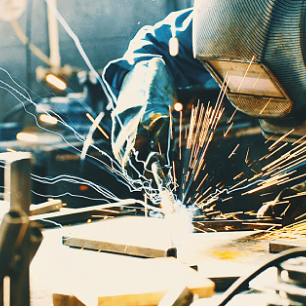Jump to:
The Evolution of Cobot Welding
Collaborative welding automation has been successfully deployed on thousands of industrial welding applications. Its proven technology reduces waste and rework, improves ergonomics, and boosts welding productivity and throughput.
The first wave of collaborative welding systems was designed to tackle low-hanging fruit: light and simple, predominantly gas metal arc welding (GMAW)-based applications that don’t require water cooling or other advanced features. GMAW is a flexible process and is easily used for a wide range of applications, from thin-gauge steel to multipass heavy deposition welds on agricultural and construction vehicles. The introduction of GMAW cobots in 2017 was quickly followed by active gas applications and control interfaces on all major welding power supply and wire feed brands.
Thanks to its low total cost of ownership, built-in safety features, small footprint, fast return on investment, and ease of use, the first wave of cobot-powered welding systems continues to be a popular choice. Recently, however, a new wave of collaborative welding systems has emerged. The second wave of collaborative welding automation delivers more functionality, usability, range, and power than its popular predecessors, showcasing a generational leap in capability.
Beyond GMAW: The Next Generation of Cobots
The next phase of the cobot welding evolution introduced gas tungsten arc welding (GTAW) systems. While GMAW is somewhat more forgiving, GTAW demands a higher level of precision and the ability to manage additional process variables to weld exotic materials such as stainless steel, titanium, carbon steel, aluminum, and others. GMAW and GTAW solutions benefited from the introduction of additional functionality, including weaving, stitch weld programming, automatic voltage control for Z-axis tracking, and touch sensing.
Plasma welding, thermal spraying, and plasma cutting systems also benefited from the inherent cobot advantages of flexibility, ease of use, lower total cost, and rapid deployment, now handling heavy-duty tasks many people would not have believed possible just a few years ago. For example, early cobot welding systems were air-cooled and couldn’t meet the demands of high-amp-rated welding applications. Many of the latest systems have water-cooled torches and can easily perform high-amp tasks, even mastering complex cuts on 3D shapes.
In 2021, cobot laser welding systems hit the market. Laser welding allows for better control and reduces distortion, deformation, undercutting, and burn-through on thin materials. It is also significantly faster than GTAW. The introduction of small, handheld laser welding equipment enhanced cobot laser welding cells, bringing down total systems cost to a level that supports payback in one year or less. By integrating the handheld laser with the cobot, companies can take advantage of the higher speeds and maximize quality through the precision positioning capabilities of the cobot. Laser welding can often replace GTAW as it can be up to four to five times faster, welding materials up to ¼ in.
Until recently, spot welding proved prohibitive for cobots due to the weight of the welding gun and the complexity of the welds. In 2023, new lightweight cobot-powered solutions were developed, delivering two to three times more manufacturing capacity than manual spot welding. Like laser welding, the systems are based on an efficient, small-footprint welding gun. These applications free operators from manually positioning thin-gauge sheet metal parts into a pedestal or resistance welding machine, greatly benefiting any manufacturer who joins sheet metal. These new systems can also capture an immense amount of data for each weld, allowing for quality control, traceability, and job repeatability.
New Features Mean New Applications
Cobots can now reach longer distances (1750 mm [68.9 in.]). Positioners that extend the effective reach of the cobot are being released, too. Having a long-reach cobot arm is helpful for handling a welding gun that is welding larger parts. It is also beneficial for cobots tending welding systems. For example, cobots can place parts into legacy resistance welding machines, relieving operators of dull and dangerous manual operations. This kind of servicing delivers a boost in throughput and allows operators to do more value-added tasks in the shop.
New accessories, like cobot-controlled rotary tables, allow users to create separate load and welding stations on a single cobot-powered system. With new coordinated motion features now available with many cobots, the cobot arm and external axis — such as a rotary positioner or linear rail robot transfer units (RTUs) — move in sync. Coordinated motion enables fabricators to weld many small parts or more-complex parts without having to manually reposition the workpiece or welding robot. This means more arc time from the cobot system, which provides more parts per shift for increased efficiency.
Bringing the Cobot to the Workpiece
Traditionally, welding robots are heavy, bulky, and stationary, which means that the workpiece must always be brought to the robot. This can be costly, time-consuming, and impractical for large or complex weldments on multistory workpieces, such as excavator buckets and mining vehicles or in shipbuilding. However, this new wave of lightweight welding cobots can be easily carried, moved, or redeployed directly to the workpiece for faster and more accurate welding in various locations. Portable cobots also reduce the risk of human exposure to hazards during the welding process through touch-to-teach technology, telewelding, joint tracking tools, and digital model-based path creation tools. By bringing the welding robot to the workpiece, the welding process becomes more convenient, productive, and economical for large weldments.
Final Thoughts
Today’s cobot welding systems add extra capability on top of the value that early cobot welding tools offered fabricators. Manual welders looking to extend their careers, reduce physical injuries, and use easy-to-operate tools, such as touch-to-teach and smartphone apps, needn’t look any further than the user-friendly programming methods and interfaces of collaborative welding.
This article was written by Will Healy III (global welding segment manager, Universal Robots) for the American Welding Society.


